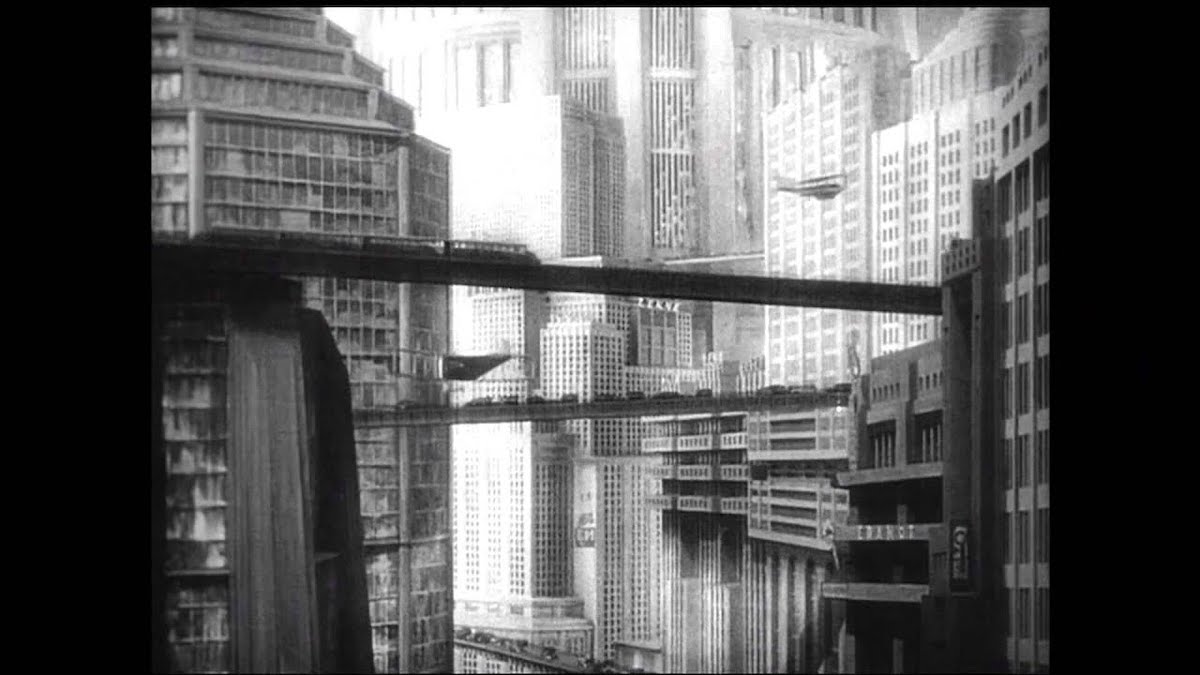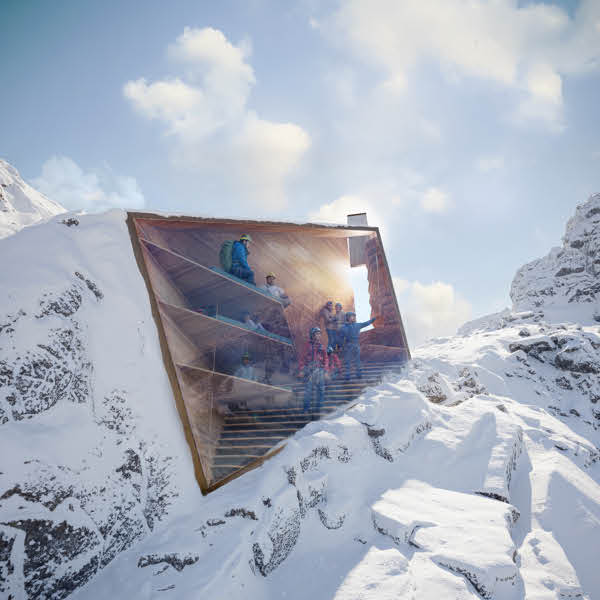
Left to right (top): Blade Runner 2049, Black Panther, Ex Machina, The Grand Budapest Hotel; left to right (bottom): Her, Inception, Parasite, High-Rise
Whether you need a great film for a quiet night in or just some background noise to help you get through your latest creative project, we've got some picks that are sure to inspire you with great stories and incredible scenes. We listed some of our favorite films that will be especially interesting to architects and architecture lovers.
Some films are included for their incredible world-building. These are great if you are getting ready to design something really wild for a concept competition or if you have been considering the impact of future technologies. Maybe you are working on all the complicated building program included in a tower design. You can always turn to High-Rise for the dramatic effects design decisions have on people, or to Blade Runner 2049 for some incredible scenery with traces of arch history.
We have also included a few films that include an architect as the main character, namely The Fountainhead, which includes the most famous representation of an architect in popular media. Keep scrolling to find your next favorite film!
Films That Architects and Architecture Lovers Must See
Blade Runner 2049 (2017)

Cityscape in Blade Runner 2049 (2017)
Synopsis: This sequel to Blade Runner (from 1982) centers around Officer K (Ryan Gosling), a blade runner for the LAPD. The film takes place in the same dystopian LA world as the original, but this time, the protagonist is a replicant who starts to uncover secrets about the world he thinks he knows. Officer K is suddenly thrown into a quest to find Richard Deckard (Harrison Ford).
Why you should watch: Blade Runner may be an obvious choice for this list. Images of the city seem to be inspired by Brutalism—a brand of architectural modernism defined by the extensive use of raw concrete or “beton brut” from which the style gets its name. For those familiar with the divided opinions on this style, which is sometimes referred to as cold or oppressive, the film seems to uphold the negative commentary surrounding Brutalism. Failed Architecture analyzes the architecture in Blade Runner 2049 and how closely it relates to the Brutalism we know.
Black Panther (2018)

Wakanda in Black Panther (2018)
Synopsis: Marvel’s Black Panther centers on T’Challa, heir to the throne of the fictional African nation of Wakanda, who returns home after the death of his father. To stop the rise of an old enemy, T’Challa and his trusted allies must fight to protect their people while the new king learns to use the power of the Black Panther.
Why you should watch: This is a decidedly stunning film with a fully realized world within it. The nation of Wakanda has well earned a place on this list. It is often cited as an inspiration for futuristic African cities currently in planning, like Akon City. It is also relevant to architects because of the technological innovation within the film—largely made possible by the fictional metal of vibranium, which reached Wakanda through a meteorite that fell long before the city’s development. As we approach a new age of material innovation, Wakanda may provide inspiration for building with new resources.
Brazil (1985)

Jack Lint Portrayed by Michael Palin in Brazil (1985)
Synopsis: If you are a fan of George Orwell’s Nineteen Eighty-Four, you may enjoy the odd sci-fi film Brazil. It features Sam Lowry (Jonathon Pryce), a bureaucrat whose life takes an odd turn when he begins dreaming of the beautiful Jill Layton (Kim Greist).
Why you should watch: Architects and designers may enjoy this film because of the alternative and often absurd machines that define the built world in the movie. Director Terry Gilliam and Charles Alverson, who worked on the screenplay and script, describe the unique environment by saying, “It is neither future nor past, and yet a bit of each. It is neither East or West, but could be Belgrade or Scunthorpe on a drizzly day in February. Or Cicero, Illinois, seen through the bottom of a beer bottle.” This is a great film for those interested in the way technology forms the cities and world we live in.
Ex Machina (2014)

Kyoko portrayed by Sonoya Mizuno and Ava portrayed by Alicia Vikander in Ex Machina (2014)
Synopsis: Caleb Smith (Domhnall Gleeson) gets selected to participate in a Turing test of eccentric CEO Nathan Bateman’s (Oscar Isaac) robot called Ava (Alicia Vikander). Caleb must spend his time discerning just how “human” Ava is.
Why you should watch: Ex Machina is a great film for architects interested in new technologies and architecture. The futuristic scenes and the luxurious background of Nathan’s home create a great backdrop for this suspenseful sci-fi film.
The Fountainhead (1949)

Architect Howard Roark portrayed by Gary Cooper with Ellsworth Toohey portrayed by Robert Douglas in The Fountainhead (1949)
Synopsis: The Fountainhead was adapted from Ayn Rand’s novel of the same name. Howard Roark is an architect who would never consider taking a commission that did not perfectly meet his artistic standards. He is also a firm believer in modernism and struggles to convince those around him to abandon outdated ideas.
Why you should watch: Howard Roark of The Fountainhead may be the most influential depiction of an architect in film. Rand’s book is an example of the individualist architect fighting for a design aesthetic unwanted by a collective who are unwilling to consider new ideas.
Ghost in the Shell (1995)

Cityscape in Ghost in the Shell (1995)
Synopsis: Cyborg Motoko Kusanagi is a security agent in 2029 Japan. She uses her skills to track down a hacker called the Puppet Master, but ends up questioning what she knows about her own identity as well.
Why you should watch: Though the live-action film faced heavy backlash for creative and casting decisions, the Ghost in the Shell anime boasts an incredible storyline, great world-building, and beautiful cyberpunk cityscapes. The unique city imagery is inspired by Hong Kong in the ’90s.
The Grand Budapest Hotel (2014)

Movie poster for The Grand Budapest Hotel (2014)
Synopsis: The Grand Budapest Hotel is a popular resort in the 1930s. Gustave H (Ralph Fiennes), a staff member at the hotel, becomes enthralled in a murder investigation of one of the guests he was sleeping with.
Why you should watch: In typical Wes Anderson fashion, the film is visually stunning with unusual colors and symmetrical compositions. The movie poster alone makes The Grand Budapest Hotel worthy of a spot on this list. But the even more vibrant and carefully composed scenes will definitely inspire you to design some colorful interiors.
Her (2013)

Theodore Twombly portrayed by Joaquin Phoenix in Her (2013)
Synopsis: Writer Theodore Twombly (Joaquin Phoenix) falls in love with an operating system similar to our modern digital assistants like Siri or Alexa. The film follows Twombly and Samantha’s complicated relationship.
Why you should watch: Though it played on a subtle role in the background, the city and clothing design created a believable futuristic world. Men were seen wearing high-waisted pants only slightly different than today’s office wear. Public spaces are wide clean spaces with modern furniture, transit spaces seem cleaner and more efficient. Plus, architecture is always influenced by future technology. For all these reasons, Her is a great film to get you thinking about the future of cities and the future of technology.
Inception (2010)

City Bending Scene in Inception (2010)
Synopsis: This iconic film follows expert thief Dom Cobb (Leonardo DiCaprio) as he attempts to implant a memory in a person’s mind. It is a far cry from his usual work of simply observing and taking information from his targets. If Cobb is able to achieve this, he gets a new shot at life. As he and other “extractors” navigate through a dream, they shape the world around them in incredible ways.
Why you should watch: The bending city scene made serious waves and has inspired designers and lots of other movie-goers since the film's 2010 release. Bjarke Ingels from BIG has even said that he thinks architecture “should be like the documentary version of Inception.” Why is this scene so popular among designers? Architects are constantly thinking of new ways to shape the city and the world around them. So, a sequence where space is completely limitless and can be manipulated in any way you imagine—a film that can visualize that move—is sure to inspire out-of-the-box thinking.
The Matrix (1999)

Lobby Scene in The Matrix (1999)
Synopsis: In this classic film, Neo (Keanu Reeves) searches for an answer to the question anyone who has not watched the movie has probably asked: “What is the Matrix?” Mysterious hacker Trinity (Carrie-Anne Moss) helps him meet Morpheus (Laurence Fishburne) who he believes can help him find the answer.
Why you should watch: The Matrix makes the list for its unique world-building and incredible futuristic structures.
Metropolis (1927)

Cityscape in Metropolis (1927)
Synopsis: The backdrop is a million-acre city partially inspired by New York City. The plot revolves around a couple: the son of the city’s designer and a “working class prophet” who believes a savior will come and ease the tensions between the poorer working class and the elite designers of the city.
Why you should watch: If you have ever seen screenshots of this 1927 film, you probably already know it is a great pick for architects or city lovers. This incredible futuristic city is sure to inspire architecture lovers.
Midnight in Paris (2011)

Movie poster for Midnight in Paris (2011) featuring Gil Pender portrayed by Owen Wilson
Synopsis: While on a trip to Paris with his fiancée Inez (Rachel McAdams) Screenwriter Gil Pender (Owen Wilson) is magically transported back in time where he gets the chance to meet artistic, literary, and entertainment legends like Ernest Hemingway, Zelda and Scott Fitzgerald, and Josephine Baker.
Why you should watch: Though not exactly related to architecture, this film is full of creative inspiration and artistic heroes.
Mon Oncle (1958)

Villa Arpel from Mon Oncle (1958)
Synopsis: The French film Mon Oncle, or My Uncle, follows the story of Monsieur Hulot (Jacques Tati), a city dweller who only subjects himself to the suburbs in order to visit his small nephew Gérard Arpel (Alain Becourt). The uncle’s sister (Adrienne Servantie) attempts to convince him to leave the dirty city for pleasant suburban life.
Why you should watch: This film is especially great for urbanists—or former urbanists—interested in the relationship between suburban versus urban life. The modernist home, Villa Arpel, is a modern single family home owned by a couple (the protagonist’s sister and brother-in-law) who strictly follow gender roles and the perfect normal family. Tati, who directed, produced, and starred in the film, explains that the modern architecture was a choice to help the audience understand the suburban family’s identity, saying: “Les lignes géométriques ne rendent pas les gens aimables” which translates to “geometric lines do not produce likeable people.”
Parasite (2019)

Kim Ki-taek portrayed by Song Kang-ho in Parasite (2019)
Synopsis: This film needs almost no introduction considering its record-breaking reputation. Classicism plays an important role as the film explores the relationship between the Park family and the Kim clan, who represent two disparate sides of a class divide in South Korea. The physical space they inhabit includes symbolic design moves that hint at this relationship.
Why you should watch: Parasite is one example of a film where architecture acts as a character. The physical space they inhabit includes symbolic design moves that hint at this relationship. Many designers recognize the role of vertical levels that create hierarchy in a project. It has never been clearer than in this 2020 film. The carefully shot scenes demonstrate power and classicism through simple architectural moves in a way that is almost hard to describe. This film is one you will just have to watch to really understand.
High-Rise (2015)

Architect Anthony Royal portrayed by Jeremy Irons in High-Rise (2015)
Synopsis: Based on the novel by J.G. Ballard, High-Rise takes place in a massive residential tower designed by a genius architect. The protagonist, Robert Laing (Tom Hiddleston), moves into the tower and begins to experience the chaotic breakdown of the residents around him. Services begin to fail, tensions rise, and fighting begins between less wealthy residents who live on lower floors and richer residents who live above them.
Why you should watch: High-Rise is one of the rare popular films that features a depiction of an architect. Architect Anthony Royal (Jeremy Irons) lives in a metaphorical ivory tower while literally placing himself above all other tenants. While chaos and class warfare erupt below, he removes himself from the consequences of his design.
Waterworld (1995)

Mariner portrayed by Kevin Costner in Waterworld (1995)
Synopsis: This film takes place after the melting of the polar ice caps which has caused global flooding. Now, most of the world is inundated and much of the human population is gone. The Mariner (Kevin Costner) is one of few humans who has adapted to this new life at sea and travels with his companions to find “Dryland.”
Why you should watch: Waterworld arguably features no “real” architecture. It is certainly difficult to find a building in the almost completely underwater world where the movie takes place. However, many designers know that world-building is an important part of design—especially when climate change means buildings and cities will soon have a new relationship with water. The unique water vehicles and water developments make this movie a must-see for architects—even if it has a less-than-stellar reputation.






















































































